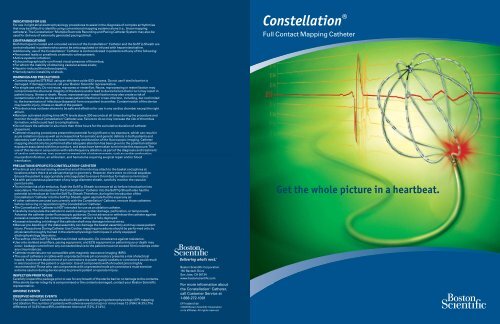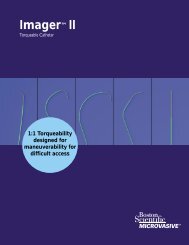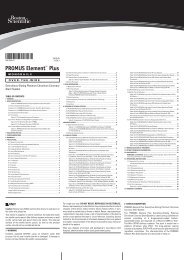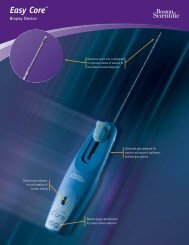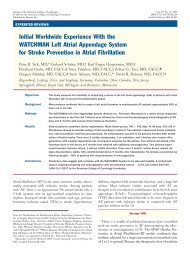Constellation Brochure:002848bsepco v6 sa ... - Boston Scientific
Constellation Brochure:002848bsepco v6 sa ... - Boston Scientific
Constellation Brochure:002848bsepco v6 sa ... - Boston Scientific
You also want an ePaper? Increase the reach of your titles
YUMPU automatically turns print PDFs into web optimized ePapers that Google loves.
INDICATIONS FOR USE<br />
For use in right atrial electrophysiology procedures to assist in the diagnosis of complex arrhythmias<br />
that may be difficult to identify using conventional mapping systems alone (i.e., linear mapping<br />
catheters). The <strong>Constellation</strong> ® Multiple Electrode Recording and Pacing Catheter System may also be<br />
used for delivery of externally generated pacing stimuli.<br />
CONTRAINDICATIONS<br />
Both the heparin-coated and uncoated version of the <strong>Constellation</strong> ® Catheter and the Soft Tip Sheath are<br />
contraindicated in patients who cannot be anticoagulated or infused with heparinized <strong>sa</strong>line.<br />
Additionally, use of the <strong>Constellation</strong> ® Catheter is contraindicated in patients with any of the following:<br />
Permanent leads or prosthetic or stenotic valves present;<br />
Active systemic infection;<br />
Echocardiographically-confirmed visual presence of thrombus;<br />
For whom the inability of obtaining vascular access exists;<br />
Heparin-induced thrombocytopenia;<br />
Hemodynamic instability or shock.<br />
WARNINGS AND PRECAUTIONS<br />
Contents supplied STERILE using an ethylene oxide (EO) process. Do not use if sterile barrier is<br />
damaged. If damage is found, call your <strong>Boston</strong> <strong>Scientific</strong> representative.<br />
For single use only. Do not reuse, reprocess or resterilize. Reuse, reprocessing or resterilization may<br />
compromise the structural integrity of the device and/or lead to device failure that in turn may result in<br />
patient injury, illness or death. Reuse, reprocessing or resterilization may also create a risk of<br />
contamination of the device and/or cause patient infection or cross-infection, including, but not limited<br />
to, the transmission of infectious disease(s) from one patient to another. Contamination of the device<br />
may lead to injury, illness or death of the patient.<br />
This device has not been shown to be <strong>sa</strong>fe and effective for use in any cardiac chamber except the right<br />
atrium.<br />
Maintain activated clotting time (ACT) levels above 300 seconds at all times during the procedure and<br />
monitor throughout <strong>Constellation</strong> ® Catheter use. Failure to do so may increase the risk of thrombus<br />
formation, which could lead to complications.<br />
Do not leave the catheter in situ more than three hours for the cumulative duration of catheter<br />
placement.<br />
Catheter mapping procedures present the potential for significant x-ray exposure, which can result in<br />
acute radiation injury as well as increased risk for somatic and genetic defects in both patients and<br />
laboratory staff due to the x-ray beam intensity and duration of the fluoroscopic imaging. Catheter<br />
mapping should only be performed after adequate attention has been given to the potential radiation<br />
exposure associated with the procedure, and steps have been taken to minimize this exposure. The<br />
use of this device in conjunction with radiofrequency ablation, as part of the diagnosis and treatment<br />
of cardiac arrhythmias, may pose an increased risk of adverse events, such as cardiac perforation,<br />
myocardial infarction, air embolism, and hematoma requiring surgical repair and/or blood<br />
transfusion.<br />
PRECAUTIONS SPECIFIC TO CONSTELLATION ® CATHETER<br />
Preclinical and clinical testing show that small thrombi may attach to the basket and splines at<br />
locations where there is an abrupt change in geometry. However, there were no clinical sequelae.<br />
Ensure the patient is appropriately anticoagulated to ensure thrombus formation is minimized.<br />
As with percutaneous placement of any large diameter sheath, carefully monitor the vascular<br />
puncture site.<br />
To minimize risk of air embolus, flush the Soft Tip Sheath to remove all air before introduction into<br />
vasculature. The introduction of the <strong>Constellation</strong> ® Catheter into the Soft Tip Sheath also has the<br />
potential to introduce air into the Soft Tip Sheath. Therefore, during the introduction of the<br />
<strong>Constellation</strong> ® Catheter into the Soft Tip Sheath, again aspirate fluid to expel any air.<br />
If other catheters are used concurrently with the <strong>Constellation</strong> ® Catheter, remove those catheters<br />
before removing or repositioning the <strong>Constellation</strong> ® Catheter.<br />
The <strong>Constellation</strong> ® Catheter is NOT intended for use as an ablation catheter.<br />
Carefully manipulate the catheter to avoid causing cardiac damage, perforation, or tamponade.<br />
Advance the catheter under fluoroscopic guidance. Do not advance or withdraw the catheter against<br />
excessive resistance. Do not torque the catheter while it is fully deployed.<br />
Excessive bending or kinking of the catheter shaft may damage internal wires.<br />
Manual pre-bending of the distal assembly can damage the basket assembly and may cause patient<br />
injury. Precautions During Catheter Use Cardiac mapping procedures should be performed only by<br />
physicians thoroughly trained in the electrophysiologic techniques in a fully equipped<br />
electrophysiology laboratory.<br />
The soft tip of the Soft Tip Sheath has limited radiopacity. Do not advance against resistance.<br />
Use only isolated amplifiers, pacing equipment, and ECG equipment or patient injury or death may<br />
occur. Leakage current from any connected device to the patient must not exceed 10 microAmps under<br />
any circumstances.<br />
Catheter materials are not compatible with magnetic resonance imaging (MRI).<br />
The use of catheters or cables with unprotected male pin connectors presents a risk of electrical<br />
hazard. Inadvertent attachment of pin connectors to power supply sockets or connectors could result<br />
in electrocution of the patient or operator. Use of components with shrouded pins is highly<br />
recommended. Those who use components with unprotected male pin connectors must exercise<br />
extreme caution during device setup to prevent patient or operator injury.<br />
INSPECTION PRIOR TO USE<br />
Carefully inspect the package prior to use for any breach of the sterile barrier or damage to the contents.<br />
If the sterile barrier integrity is compromised or the contents damaged, contact your <strong>Boston</strong> <strong>Scientific</strong><br />
representative.<br />
ADVERSE EVENTS<br />
OBSERVED ADVERSE EVENTS<br />
The <strong>Constellation</strong> ® Catheter was studied in 84 patients undergoing electrophysiologic (EP) mapping<br />
and ablation. The number of patients with adverse events (major or minor) was 12 of 84 (14.3%). The<br />
difference of 14.3% has a 95% confidence interval of [7.2%, 21.4%].<br />
<strong>Boston</strong> <strong>Scientific</strong> Corporation<br />
150 Baytech Drive<br />
San Jose, CA 95134<br />
www.bostonscientific.com<br />
For more information about<br />
the <strong>Constellation</strong> ® Catheter,<br />
call Customer Service at<br />
1-888-272-1001<br />
EPT-10496-07/09<br />
©2009 <strong>Boston</strong> <strong>Scientific</strong> Corporation<br />
or its affiliates. All rights reserved.<br />
<strong>Constellation</strong> ®<br />
Full Contact Mapping Catheter<br />
Get the whole picture in a heartbeat.
<strong>Constellation</strong> ®<br />
Full Contact Mapping Catheter<br />
Comprehensive, Full-Contact Mapping<br />
Provides comprehensive, real-time mapping<br />
in just one heart cycle<br />
Pacing capabilities facilitate the assessment<br />
of entrainment, conduction velocity studies,<br />
and refractory period<br />
Simultaneous longitudinal and<br />
circumferential signals for more<br />
accurate 3-D mapping<br />
Super-elastic alloy spline construction<br />
Fully deployed<br />
<strong>Constellation</strong> Catheter<br />
in right atrium<br />
Necking of <strong>Constellation</strong><br />
Catheter positioned<br />
in the SVC Ostium<br />
Efficiently map focal<br />
arrhythmias in real-time<br />
Proven Effective and Efficient<br />
Unique, flexible basket design conforms to<br />
atrial anatomy to aid in accurate placement<br />
and to <strong>sa</strong>ve repositioning time<br />
64 electrodes provide comprehensive,<br />
real-time 3-D information in a single beat<br />
High resolution electrograms facilitate<br />
identification of earliest activation site(s)<br />
Remote display allows precise orientation<br />
of ablation catheter<br />
Switching/Locating Remote Display<br />
Provides comprehensive, real-time visual<br />
feedback and efficient 3-D mapping<br />
Facilitates ablation catheter positioning<br />
Enables more accurate ablation<br />
Reduces need for fluoro


